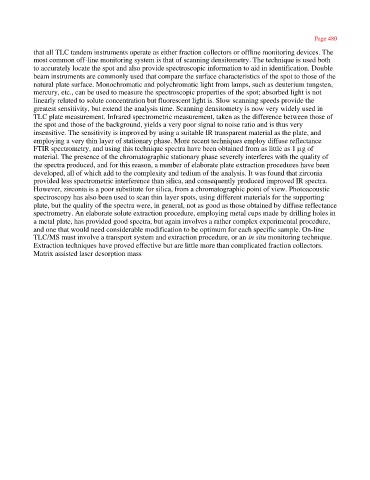Page 495 - Tandem Techniques
P. 495
Page 480
that all TLC tandem instruments operate as either fraction collectors or offline monitoring devices. The
most common off-line monitoring system is that of scanning densitometry. The technique is used both
to accurately locate the spot and also provide spectroscopic information to aid in identification. Double
beam instruments are commonly used that compare the surface characteristics of the spot to those of the
natural plate surface. Monochromatic and polychromatic light from lamps, such as deuterium tungsten,
mercury, etc., can be used to measure the spectroscopic properties of the spot; absorbed light is not
linearly related to solute concentration but fluorescent light is. Slow scanning speeds provide the
greatest sensitivity, but extend the analysis time. Scanning densitometry is now very widely used in
TLC plate measurement. Infrared spectrometric measurement, taken as the difference between those of
the spot and those of the background, yields a very poor signal to noise ratio and is thus very
insensitive. The sensitivity is improved by using a suitable IR transparent material as the plate, and
employing a very thin layer of stationary phase. More recent techniques employ diffuse reflectance
FTIR spectrometry, and using this technique spectra have been obtained from as little as 1 µg of
material. The presence of the chromatographic stationary phase severely interferes with the quality of
the spectra produced, and for this reason, a number of elaborate plate extraction procedures have been
developed, all of which add to the complexity and tedium of the analysis. It was found that zirconia
provided less spectrometric interference than silica, and consequently produced improved IR spectra.
However, zirconia is a poor substitute for silica, from a chromatographic point of view. Photoacoustic
spectroscopy has also been used to scan thin layer spots, using different materials for the supporting
plate, but the quality of the spectra were, in general, not as good as those obtained by diffuse reflectance
spectrometry. An elaborate solute extraction procedure, employing metal cups made by drilling holes in
a metal plate, has provided good spectra, but again involves a rather complex experimental procedure,
and one that would need considerable modification to be optimum for each specific sample. On-line
TLC/MS must involve a transport system and extraction procedure, or an in situ monitoring technique.
Extraction techniques have proved effective but are little more than complicated fraction collectors.
Matrix assisted laser desorption mass

